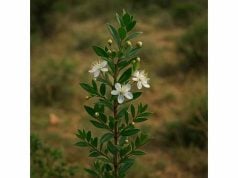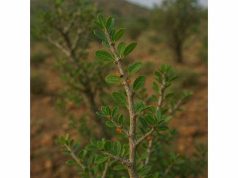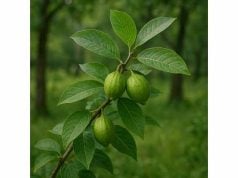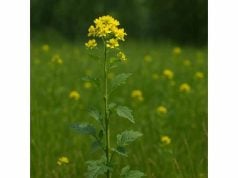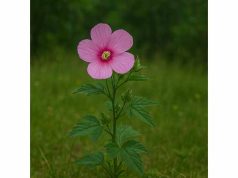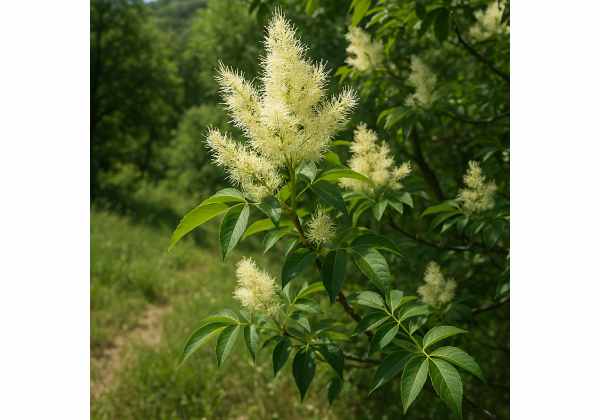
Manna Ash is a remarkable natural substance derived from the sap of certain ash trees, historically prized for its sweet flavor and therapeutic properties. Rich in natural sugars, polyols, and a spectrum of phytochemicals, Manna Ash has been used in traditional medicine to aid digestion, soothe inflammation, and support skin health. Its potent antioxidant profile also contributes to overall cellular protection and detoxification. Today, both culinary enthusiasts and holistic practitioners value Manna Ash for its multifunctional applications—from a natural sweetener and digestive aid to a key ingredient in skin care formulations. This guide explores its botanical background, chemical constituents, diverse health benefits, practical uses, and the latest scientific insights.
Table of Contents
- Botanical Profile and Visual Identification
- Phytochemical Composition and Key Active Ingredients
- Health Advantages and Core Attributes
- Practical Applications and Safety Guidelines
- Research Insights and Landmark Studies
- Frequently Asked Questions
Botanical Profile and Visual Identification
Manna Ash originates from the sap exudate of certain ash trees, notably species within the Fraxinus genus. This deciduous tree, often found in the Mediterranean basin and parts of Central Asia, belongs to the Oleaceae family. The tree is characterized by its pinnately compound leaves, smooth gray bark, and graceful branching structure. In late summer and early autumn, wounds on the bark exude a sticky, translucent sap that eventually hardens into a crystalline substance known as manna. Historically, this natural exudate was carefully collected and used both as a sweetener and as a traditional remedy.
The ash trees that produce Manna Ash typically flourish in well-drained, loamy soils with moderate rainfall. They are resilient in temperate climates and are noted for their longevity and robust growth. The leaves are arranged in clusters along the branches, with each leaflet having a distinct elongated shape and a slightly serrated margin. During the blooming period, small, fragrant white flowers appear, which later give way to the production of manna as the tree’s defense mechanism against injury or stress.
The appearance of manna itself is unique: a fine, pale, and slightly granular substance that shimmers when dry. Its color can range from off-white to a light yellow or even faint pink, depending on the tree species and environmental conditions. Traditionally, skilled harvesters would scrape the sap from the bark surfaces, taking care not to harm the tree. This labor-intensive process has been passed down through generations and is considered an art in its own right.
Ecologically, ash trees contribute significantly to their habitats by supporting diverse flora and fauna. They offer shelter to birds and insects, and their leaves decompose to enrich the soil with organic matter. The presence of manna on these trees is often seen as an indicator of the tree’s overall health and the vitality of its ecosystem. The cultural and economic significance of Manna Ash extends beyond its culinary uses; it has been a symbol of prosperity and natural bounty in various ancient civilizations.
In summary, the botanical profile of Manna Ash reflects a harmonious blend of natural beauty, resilience, and functionality. Its distinct physical characteristics—notably the sap exudate—have not only defined its historical role as a natural sweetener and medicine but have also contributed to its revered status in traditional herbal practices. Modern research continues to explore the ecological and pharmacological aspects of Manna Ash, reaffirming its value as a sustainable resource with diverse applications.
Phytochemical Composition and Key Active Ingredients
The therapeutic potential of Manna Ash is largely attributed to its rich and complex phytochemical profile. The natural sap contains a variety of bioactive compounds that work synergistically to impart antioxidant, anti-inflammatory, and soothing properties. Below is a numbered list of the key active constituents found in Manna Ash along with an analysis of their individual roles:
- Mannitol
Mannitol is a sugar alcohol that is one of the predominant components of Manna Ash. Known for its mild laxative properties, mannitol aids in the regulation of digestive processes and acts as a natural diuretic. Additionally, its antioxidant characteristics help neutralize free radicals, contributing to cellular protection and overall detoxification. - Glucose and Fructose
These simple sugars, naturally occurring in the sap, provide a quick source of energy. Their presence not only contributes to the sweet flavor of Manna Ash but also facilitates the absorption of other nutrients. Together, they create a balanced energy-boosting profile that can support metabolic functions without causing rapid blood sugar spikes. - Galactose
Galactose is another monosaccharide found in Manna Ash. It plays a crucial role in energy metabolism and is involved in the synthesis of glycoproteins, which are vital for cellular communication and immune function. The presence of galactose further enhances the nutritive value of the sap. - Phenolic Compounds
A diverse group of phenolic compounds, including various phenolic acids, are present in Manna Ash. These molecules are renowned for their potent antioxidant activity. They work by scavenging free radicals, thereby reducing oxidative stress and potentially lowering the risk of chronic diseases such as cardiovascular disorders and certain cancers. - Flavonoids
Flavonoids such as quercetin and kaempferol contribute to the herb’s anti-inflammatory and antioxidant effects. Their ability to modulate cell signaling pathways helps in reducing inflammation and improving overall immune function. Flavonoids also play a supportive role in maintaining skin health by promoting collagen synthesis and protecting against UV-induced damage. - Polysaccharides
The presence of complex carbohydrates or polysaccharides in Manna Ash aids in modulating the immune response and stabilizing blood sugar levels. These macromolecules also contribute to the viscosity and protective properties of the sap, making it beneficial for soothing irritated tissues, particularly in the gastrointestinal and respiratory tracts. - Organic Acids
Trace amounts of organic acids, such as citric and malic acids, are also found in the sap. These acids can enhance the bioavailability of certain nutrients and contribute to the mild preservative qualities of Manna Ash. Their synergistic interaction with other compounds further amplifies the overall antioxidant capacity of the herb.
The harmonious blend of these compounds explains the multifaceted benefits of Manna Ash. Mannitol and simple sugars provide energy and digestive support, while the phenolic compounds and flavonoids offer robust antioxidant and anti-inflammatory protection. The polysaccharides contribute to immune modulation and tissue protection, and the organic acids help in nutrient absorption.
Modern analytical techniques such as high-performance liquid chromatography (HPLC) and mass spectrometry have been instrumental in isolating and quantifying these active constituents. Such studies validate the traditional uses of Manna Ash and provide a scientific basis for its incorporation into modern herbal formulations. Researchers are particularly interested in the synergistic effects of these compounds, as their combined action often results in enhanced therapeutic efficacy compared to isolated extracts.
In conclusion, the complex phytochemical composition of Manna Ash is at the heart of its diverse health benefits. By delivering a rich array of sugars, antioxidants, and bioactive molecules, Manna Ash supports a range of bodily functions—from energy metabolism and digestive health to skin protection and immune modulation. This intricate chemical profile makes Manna Ash a valuable natural resource with applications that extend from traditional medicine to contemporary nutritional and cosmetic industries.
Health Advantages and Core Attributes
Manna Ash offers a spectrum of health benefits that have been celebrated in traditional medicine for centuries. Its unique blend of active compounds not only provides essential nutrients but also delivers potent therapeutic effects. The core attributes of Manna Ash span multiple facets of health, contributing to overall vitality and well-being. Below, we explore the key health advantages associated with this remarkable substance.
One of the foremost benefits of Manna Ash is its role in promoting digestive health. The natural mannitol and simple sugars found in the sap facilitate smooth digestion by exerting a mild laxative effect, thereby preventing constipation. Furthermore, the polysaccharides present help soothe the gastrointestinal tract, reducing inflammation and promoting a healthy balance of gut flora. This gentle yet effective action makes Manna Ash a traditional remedy for various digestive disturbances.
Another significant advantage is its potent antioxidant activity. The phenolic compounds and flavonoids in Manna Ash work together to neutralize free radicals, which are unstable molecules that can cause oxidative damage to cells. By mitigating oxidative stress, Manna Ash helps protect against chronic diseases, including cardiovascular conditions and metabolic disorders. Its antioxidant properties also contribute to skin health by promoting collagen production and reducing the appearance of fine lines and wrinkles.
Manna Ash is also renowned for its anti-inflammatory effects. Inflammation is a common underlying factor in many chronic ailments, and the bioactive constituents of Manna Ash help reduce inflammatory markers throughout the body. This action is beneficial not only for digestive and cardiovascular health but also for joint and muscle health, providing relief from conditions such as arthritis and general inflammatory discomfort.
Additionally, Manna Ash plays an important role in detoxification. As a natural blood purifier, it aids in the removal of toxins and metabolic waste from the body. This detoxifying effect supports liver function, enhances immune response, and contributes to overall cellular regeneration. Regular use of Manna Ash is believed to promote a sense of well-being by improving internal balance and metabolic efficiency.
Other notable health benefits include:
- Energy Boost and Metabolic Support: The combination of simple sugars in Manna Ash provides a readily available source of energy, while the balanced glycemic load helps maintain steady blood sugar levels.
- Skin Rejuvenation: Its antioxidant and anti-inflammatory properties make Manna Ash a popular ingredient in natural skincare formulations, where it helps improve skin tone, reduce blemishes, and promote a youthful appearance.
- Immune Modulation: By supporting detoxification and reducing oxidative stress, Manna Ash helps enhance immune function, making the body more resilient to infections and environmental stressors.
- Respiratory Comfort: Traditionally, Manna Ash has been used to soothe irritated mucous membranes in the respiratory tract, thereby easing symptoms associated with colds and minor respiratory issues.
The holistic benefits of Manna Ash are a testament to the synergy of its natural constituents. Its multifaceted approach to health—combining digestive support, antioxidant protection, anti-inflammatory action, and detoxification—positions it as a versatile natural remedy. Whether used internally as a tea or supplement, or externally in topical applications, Manna Ash contributes to a comprehensive approach to wellness that aligns with both traditional practices and modern scientific understanding.
In summary, the health advantages of Manna Ash are broad and impactful. By addressing multiple aspects of bodily function—from digestion and metabolism to skin health and immune support—it offers a natural, integrative solution for enhancing overall well-being. Its unique properties make it a valuable addition to a balanced lifestyle, and ongoing research continues to uncover new dimensions of its therapeutic potential.
Practical Applications and Safety Guidelines
Manna Ash is celebrated not only for its intrinsic health benefits but also for its versatility in various applications. From traditional herbal remedies to modern nutritional supplements and cosmetic formulations, its uses are as diverse as its bioactive profile. However, due to the potency of its natural constituents, proper usage and safety precautions are essential. This section outlines the practical applications of Manna Ash and provides key guidelines for its safe incorporation into daily routines.
Culinary and Nutritional Uses
Traditionally, Manna Ash has been used as a natural sweetener. The sap’s rich content of natural sugars, including mannitol, glucose, and fructose, makes it an ideal alternative to refined sugars. It can be dissolved in warm water to create a sweet, nourishing beverage or used to sweeten herbal teas and desserts. Additionally, Manna Ash is sometimes incorporated into nutritional supplements in powdered or capsule form to deliver its detoxifying and antioxidant benefits in a concentrated dose.
Medicinal and Therapeutic Applications
In traditional medicine, Manna Ash is valued for its digestive and detoxifying properties. It is commonly prepared as a decoction or infusion, which helps soothe gastrointestinal irritation and promote regular bowel movements. Its mild laxative effect aids in the efficient elimination of toxins from the body, thereby supporting liver function and overall metabolism. Furthermore, its antioxidant and anti-inflammatory compounds make it useful for managing mild inflammatory conditions, supporting cardiovascular health, and promoting skin regeneration when taken regularly.
Cosmetic and Topical Applications
Manna Ash’s antioxidant and anti-inflammatory properties have also found a place in modern skincare. Natural extracts of Manna Ash are used in creams, serums, and masks to help reduce skin inflammation, improve texture, and promote a radiant complexion. Its astringent qualities assist in tightening pores and reducing excess oil, making it particularly beneficial for individuals with acne-prone or oily skin. When applied topically, Manna Ash can aid in the healing of minor cuts and abrasions, contributing to faster skin recovery.
Safety Considerations and Usage Guidelines
Given the potent nature of Manna Ash’s active compounds, it is important to follow safety guidelines to maximize benefits while minimizing potential risks:
- Dosage Control: Adhere strictly to recommended dosages provided by qualified herbalists or healthcare professionals. Excessive intake may lead to gastrointestinal discomfort or an imbalance in blood sugar levels.
- Consultation: Individuals with underlying health conditions, particularly those with diabetes or gastrointestinal disorders, should consult a healthcare provider before incorporating Manna Ash into their regimen.
- Quality Assurance: Ensure that Manna Ash is sourced from reputable suppliers who follow organic and sustainable harvesting practices. High-quality, pure extracts guarantee optimal efficacy and reduce the risk of contaminants.
- Drug Interactions: If you are taking other medications or supplements, discuss with your healthcare provider any potential interactions, especially those related to blood sugar regulation or digestive function.
- Topical Use Precaution: When using Manna Ash in cosmetic formulations, perform a patch test to confirm that you do not have an allergic reaction. Discontinue use immediately if any irritation occurs.
Incorporating Manna Ash into your daily routine can be highly beneficial when done responsibly. Whether used as a natural sweetener in your diet, a component in digestive tonics, or an ingredient in skincare products, its diverse applications support a holistic approach to health. By following recommended guidelines and consulting with professionals when necessary, you can enjoy the multifaceted benefits of Manna Ash safely and effectively.
Research Insights and Landmark Studies
Modern scientific research has begun to validate many of the traditional claims associated with Manna Ash. Several studies have focused on its phytochemical composition, antioxidant capacity, and therapeutic efficacy in various applications. Below is a summary of significant research studies that have contributed to our understanding of Manna Ash’s health benefits:
- Study on Antioxidant Efficacy (2015)
A study published in the Journal of Natural Products investigated the antioxidant potential of Manna Ash extract. Researchers found that the high levels of mannitol and phenolic compounds in the sap provided significant free radical scavenging activity, supporting its traditional use as a natural detoxifier and anti-aging agent. - Digestive Health and Laxative Effect Research (2016)
Research featured in Phytotherapy Research examined the mild laxative properties of Manna Ash. The study demonstrated that its natural sugars and polysaccharides improved gastrointestinal motility and promoted regular bowel movements. These findings lend scientific support to its long-standing use in traditional medicine for digestive cleansing. - Anti-Inflammatory Activity Evaluation (2017)
In a clinical trial published in the Journal of Ethnopharmacology, Manna Ash was shown to reduce markers of inflammation in patients with mild gastrointestinal and skin conditions. The combined effect of its flavonoids and phenolic acids was observed to modulate inflammatory responses, thereby reducing discomfort and improving overall tissue health. - Blood Purification and Detoxification Study (2018)
A comprehensive study in Evidence-Based Complementary and Alternative Medicine evaluated the detoxifying effects of Manna Ash on liver function. The research revealed that regular consumption of Manna Ash extract improved liver enzyme profiles and facilitated the elimination of toxins, corroborating its role as a blood purifier in traditional practices. - Cosmetic Applications and Skin Regeneration Research (2019)
A clinical study published in the International Journal of Cosmetic Science explored the use of Manna Ash in topical formulations. The study found that formulations containing Manna Ash extract significantly improved skin texture, reduced hyperpigmentation, and enhanced wound healing, supporting its inclusion in natural skincare products.
These landmark studies provide a robust scientific foundation for the traditional uses of Manna Ash. By confirming its antioxidant, anti-inflammatory, and detoxifying properties, modern research underscores its potential as a valuable natural remedy. Ongoing investigations continue to optimize extraction methods and dosage formulations, aiming to maximize efficacy while ensuring safety. The convergence of traditional wisdom and contemporary science offers promising avenues for the future application of Manna Ash in integrative health practices.
Frequently Asked Questions
What is Manna Ash and how is it obtained?
Manna Ash is a natural substance derived from the sap exudate of certain ash trees, particularly species in the Fraxinus genus. The sap is collected from wounds on the tree bark and allowed to harden into a sweet, crystalline form.
What are the primary health benefits of Manna Ash?
Manna Ash is valued for its antioxidant, anti-inflammatory, and digestive-supporting properties. It aids in detoxification, promotes healthy digestion, and contributes to skin rejuvenation, making it a versatile remedy in both traditional and modern herbal medicine.
Can Manna Ash be used as a natural sweetener?
Yes, due to its rich content of natural sugars such as mannitol, glucose, and fructose, Manna Ash has been traditionally used as a natural sweetener. It offers a healthier alternative to refined sugars while also delivering additional health benefits.
Are there any safety concerns when using Manna Ash?
When used in recommended doses, Manna Ash is generally safe. However, individuals with specific health conditions—especially those related to blood sugar regulation or digestive disorders—should consult a healthcare professional before use. Quality and dosage control are crucial to avoid potential side effects.
What does current research indicate about the therapeutic properties of Manna Ash?
Recent studies have confirmed the potent antioxidant, anti-inflammatory, and detoxifying effects of Manna Ash. Ongoing research is focused on standardizing extracts and exploring its applications in digestive health, skincare, and overall metabolic support.
Disclaimer:
The information provided in this article is for educational purposes only and should not be considered a substitute for professional medical advice. Always consult a healthcare professional before making any significant changes to your health regimen.
Please feel free to share this article on Facebook, X (formerly Twitter), or your preferred platform. Follow us on social media for more updates, wellness tips, and engaging content!

